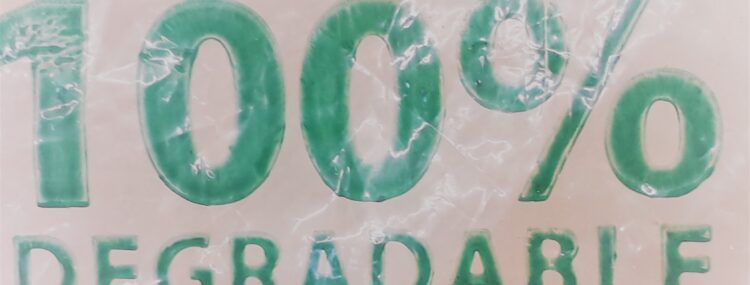
Beware Biodegradables!
There has been a lot of talk about ‘biodegradable plastics’ recently and it is being touted by many businesses as the solution to the problem of single use plastics. But this term ‘biodegradable’ seems to me to be misleading people and, when you dig a bit deeper, it isn’t necessarily any better than the original plastic material! In this post I look at the different types of ‘biodegradable plastics’ to see whether they are in fact better, the same, or worse than the current plastics being used.
What is ‘biodegradable plastic’?
First of all, the definition of ‘biodegradable plastic’:
“degradable plastic in which degradation results in lower molecular weight fragments produced by the action of naturally occurring microorganisms such as bacteria, fungi and algae” – Defra report Assessing the Environmental Impacts of Oxo-degradable Plastics Across Their Life Cycle
Often the terms compostable and biodegradable are used interchangeably but this should not be the case. The definition of biodegradable plastic does not specify the extent, time-scale or conditions under which biodegradation takes place nor what the molecular fragments which result are. The definition of compostable plastic on the other hand is much more specific.
“A plastic that undergoes degradation by biological processes during composting to yield CO2, water, inorganic compounds and biomass at a rate consistent with other known compostable materials and leaves no visible, distinguishable or toxic waste.” – Defra report Assessing the Environmental Impacts of Oxo-degradable Plastics Across Their Life Cycle
To complicate the issue of biodegradable plastic, there are quite a few different types:
Bioplastics – these plastics are made of components derived from renewable raw materials, e.g. cornstarch.
Petrochemical biodegradable plastics – plastics containing a biodegradable additive which enhances biodegradation. Includes:
Oxo-degradable plastics – contain a pro-degradant additive (often using metals, cobalt, lead, etc.) which breaks the molecular chains in the polymers, allowing the material to biodegrade. Bacteria and fund consume the material after the additive has reduced the molecular weight. This initial process requires the presence of oxygen.
Hydro-degradable plastics – similar to oxo-degradable but requires the presence of water for the initial process
The problem with biodegradable plastic
There are several BIG problems with ‘biodegradable plastics’.
Firstly, and in my opinion crucially, currently there are very few councils offering a household collection service for these types of plastic. Before any material goes on the market, the method of its disposal should have been considered. With no specific collection service for biodegradable plastics, these materials are being placed in food waste bins, recycling, landfill and even garden waste. It is entirely possible some people will have put it in their home compost bin in the belief that it will break down naturally. This will not happen as the conditions just aren’t right in home composting. They aren’t right in most UK waste disposal systems either. The packaging itself includes no or very little guidance to users as to what to do with it once it has been used and this leads to confusion. The worst thing is that as well as these materials not being disposed of correctly, they are also contaminating other waste streams. For example, in Carmarthenshire there is even a warning on the local authority’s website not to put biodegradable plastic in food waste bins.
“Please do not put your food waste in plastic bags (this includes biodegradable bags) as any plastic would contaminate the whole vehicle load which would then have to go to landfill.”
But there is no information on what people should do with this waste. This is a prime example of businesses just green washing an issue and passing it on to someone else.
Secondly, supposing these biodegradable plastics are able to degrade as their design intends, once they complete their first stage of degradation they give rise to microplastics which sit in the environment for several years before the bacteria and fungi can break it down. We have all heard the dangers of microplastic but I’m not afraid to repeat it here. Microplastics get into water ways and reach the sea. They get eaten (and drank) by animals and humans and then they accumulate in our bodies and can cause serious damage.
Thirdly, biodegradable plastics still require energy and resources to make for a product which is used for such a very short period of time. This brings us back to our never ending campaign for reusables! We need to be working towards a circular economy where the true value of resources is realised and products are made to last and be reused. Disposal should be a last resort but even then, the material should be recyclable at the very least. Why would we put energy and resources into this one way system?
Finally, one of the problems I see from this rise in ‘biodegradable plastics’ is the fact that businesses are claiming it is a solution. Consumers may be fooled into thinking they are shopping sustainably and choosing an environmentally friendly alternative when really it is all a marketing ploy. This really is demonstrated clearly by the conflicting information available on the internet. Sources from businesses all highlight the fact that oxo-degradable plastics and other biodegradable plastics will break down and that this solves the problem of plastic pollution. On the other hand, Defra commissioned a report from Loughborough University which found that, although these plastics will break down more quickly than traditional plastics, this does not improve their environmental impact and potentially gives rise to certain negative effects.
Ultimately, we need to invest in reusables. Compostable packaging and bioplastics may offer a partial solution to the problem of single use packaging but ‘biodegradable plastic’ is such a vague and misused term that they are worth steering clear of. There is no question that reusables have their own environmental impacts but, over a long period of time, these are much smaller than for single use plastics.

4 Comments
Great informative information! Thanks for sharing
Thank you for clarifying this issue for me and the rest of all consumers,keep up the good work.
What do you think of the two farmers crisp packets- compostable?? a good option? My family are mad for crisps and It worries me the amount of packets go in the bin 🙁 is there a zero waste option??
Hi :). Crisps are a challenge for lots of people. We stock a range of savoury snacks (salt & vinegar fava beans, salted green peas, and horseradish green peas) which are a pretty good replacement for crisps and would be the best option in terms of zero waste as you can bring in your own reusable container. The Two Farmers crisps packets are pretty good though and, having had a quick look, they seem a pretty sustainable option as they are effectively made of wood pulp and you can compost them in domestic composting conditions. Hope that helps :).
Leave a Comment